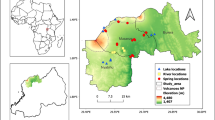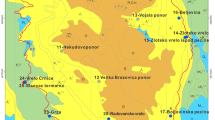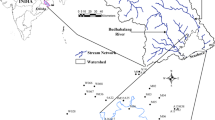Abstract
Correct understanding of groundwater/surface-water (GW–SW) interaction in karst systems is of greatest importance for managing the water resources. A typical karst region, Fangshan in northern China, was selected as a case study. Groundwater levels and hydrochemistry analyses, together with isotope data based on hydrogeological field investigations, were used to assess the GW–SW interaction. Chemistry data reveal that water type and the concentration of cations in the groundwater are consistent with those of the surface water. Stable isotope ratios of all samples are close to the local meteoric water line, and the 3H concentrations of surface water and groundwater samples are close to that of rainfall, so isotopes also confirm that karst groundwater is recharged by rainfall. Cross-correlation analysis reveals that rainfall leads to a rise in groundwater level with a lag time of 2 months and groundwater exploitation leads to a fall within 1 month. Spectral analysis also reveals that groundwater level, groundwater exploitation and rainfall have significantly similar response periods, indicating their possible inter-relationship. Furthermore, a multiple nonlinear regression model indicates that groundwater level can be negatively correlated with groundwater exploitation, and positively correlated with rainfall. The overall results revealed that groundwater level has a close correlation with groundwater exploitation and rainfall, and they are indicative of a close hydraulic connection and interaction between surface water and groundwater in this karst system.
Résumé
Une bonne compréhension des interactions entre les eaux souterraines et les eaux de surface (ESO–ESU) des systèmes karstiques est essentiel pour la gestion des ressources en eau. Une région karstique typique, Fangshan dans le nord de la Chine, a été choisie comme cas d’étude. Les niveaux piézométriques et les analyses hydrochimiques, couplés aux données isotopiques basées sur les investigations hydrogéologiques de terrain, ont été utilisés pour évaluer les interaction ESO–ESU. Les données de la chimie révèlent que le type d’eau et la concentration en cations dans les eaux souterraines sont compatibles avec celles des eaux de surface. Les rapports des isotopes stables de tous les échantillons sont proches de la line d’eau météorique locale, et les concentrations en 3H des échantillons d’eau de surface et d’eaux souterraines sont proches de celles des précipitations, ainsi les isotopes confirment également que les eaux souterraines karstiques sont rechargées par les précipitations. Des analyses corrélatoires croisées révèlent que les précipitations entraînent une augmentation du niveau piézométrique avec un délai de deux mois et que l’exploitation des eaux souterraines provoque une diminution un mois plus tard. L’analyse spectrale révèle également que le niveau piézométriques, l’exploitation des eaux souterraines et les précipitations ont sensiblement des périodes de réponses similaires, indiquant leur possible inter-relation. De plus, un modèle de régression multiple non linéaire indique que le niveau piézométrique peut être corrélé négativement avec l’exploitation des eaux souterraines, et de manière positive avec les précipitations. L’ensemble des résultats révèle que le niveau piézométrique est étroitement lié à l’exploitation des eaux souterraines et aux précipitations, et ce qui témoigne d’une connexion hydraulique étroite et d’une interaction entre les eaux de surface et les eaux souterraines au sein de ce système karstique.
Resumen
Un conocimiento correcto de la interacción agua subterránea/agua superficial (GW–SW) en los sistemas kársticos es de mayor importancia para el manejo de los recursos hídricos. Se seleccionó como caso de estudio una región kárstica típica, Fangshan, en el norte de China. Se utilizaron los niveles de agua subterránea y los análisis hidroquímicos, junto con los datos isotópicos en base a las investigaciones hidrogeológicas de campo, para evaluar la interacción GW–SW. Los datos químicos revelan que el tipo de agua y la concentración de cationes en el agua subterránea son consistentes con los del agua superficial. Las proporciones de isótopos estables de todas las muestras están cerca de la línea de agua meteórica local, y las concentraciones de agua superficial y agua subterránea están cercanas a las precipitaciones, por lo que los isótopos también confirman que el agua subterránea kárstica es recargada por la lluvia. El análisis de correlación cruzada revela que la precipitación conduce a un aumento del nivel de agua subterránea con un tiempo de retraso de dos meses y la explotación de agua subterránea lleva a una caída en un mes. El análisis espectral también revela que el nivel del agua subterránea, la explotación del agua subterránea y las precipitaciones tienen períodos de respuesta significativamente similares, lo que indica su posible interrelación. Además, un modelo de regresión múltiple no lineal indica que el nivel del agua subterránea puede estar correlacionado negativamente con la explotación del agua subterránea, y positivamente con la precipitación. Los resultados globales muestran que el nivel del agua subterránea tiene una estrecha correlación con la explotación del agua subterránea y la precipitación, y son indicativos de una conexión hidráulica estrecha y la interacción entre el agua superficial y el agua subterránea en este sistema kárstico.
摘要
正确认识与理解地下水与地表水的相互作用,对于岩溶地区水资源管理具有重要的意义。以中国北方的房山典型岩溶区为例,在水文地质野外调查的基础上,结合地下水动态监测、水化学以及同位素等数据,利用水化学分析、同位素分析、互相关分析、频谱分析及多元非线性回归模型等多种方法分析识别地下水与地表水的相互作用。结果表明:水化学特征上,该区地下水与地表水的水化学类型及离子浓度具有高度一致性,稳定同位素比值接近当地大气降水线,且地表水和地下水氚的浓度与降雨中氚的浓度差别不大,表明该区地下水主要接受降雨补给。动态特征上,互相关分析结果显示降雨与地下水位波动关系密切,滞后时间为两个月,地下水开采会引起地下水位下降,滞后时间为一个月。光谱分析结果显示地下水位,地下水开采和降雨具有相似的显著周期,表明三者之间存在一定的相关性。地下水位与地下水开采量、降雨量多元非线性回归模型结果显示地下水位与地下水开采量呈负相关,而与降雨量呈正相关。经过以上分析可知,地下水位与地下水开采及降雨密切相关,也证明了房山岩溶地区地表水和地下水之间存在密切的水力联系和相互作用。
Resumo
O claro entendimento da interação água subterrânea/água superficial (ASub–ASup) em sistemas cársticos é de grande importância para o gerenciamento de recursos hídricos. Uma típica região cárstica, em Fangshan no Norte da China, foi selecionada para um estudo de caso. Análises hidroquímicas e dos níveis da água, juntamente com dados de isótopos baseados em investigações hidrogeológicas de campo, foram utilizados para avaliar a interação ASub–ASup. Dados químicos revelaram que o tipo da água e a concentração de cátions nas águas subterrâneas são consistentes com os das águas superficiais. As taxas de isótopos estáveis de todas amostras estão próximas da linha de água meteórica local, e as concentrações de 3H das amostras de águas superficiais e subterrâneas estão próximas das de precipitação, portanto os isótopos também confirmam que a água subterrânea do carste é recarregada pela chuva. Análises de correlação cruzada revelam que a precipitação leva a um aumento no nível das águas subterrâneas com um tempo de atraso de dois meses e a explotação provoca uma queda dentro de um mês. Análises espectrais também revelaram que os níveis das águas subterrâneas, explotação e precipitação possuem períodos de resposta significativamente semelhantes, indicando sua possível inter-relação. Ademais, um modelo de regressão linear múltipla indica que o nível das águas subterrâneas pode ser correlacionado negativamente com a explotação de águas subterrâneas, e positivamente correlacionado com a chuva. Os resultados gerais revelam que o nível das águas subterrâneas possui uma estreita correlação com a explotação de águas subterrâneas e precipitação, e eles são indicativos de uma estreita conexão e interação hidráulica entre as águas superficiais e subterrâneas em sistemas cársticos.










Similar content being viewed by others
References
Allocca V, De Vita P, Manna F, Nimmo JR (2015) Groundwater recharge assessment at local and episodic scale in a soil mantled perched karst aquifer in southern Italy. J Hydrol 529:843–853
Banks EW, Simmons CT, Love AJ, Cranswick R, Werner AD, Bestland EA, Wood M, Wilson T (2009) Fractured bedrock and saprolite hydrogeologic controls on groundwater/surface-water interaction: a conceptual model (Australia). Hydrogeol J 17(8):1969–1989
Brunner P, Simmons CT, Cook PG, Therrien R (2010) Modeling surface water-groundwater interaction with MODFLOW: some considerations. Ground Water 48(2):174–180
Bureau of Geology and Mineral Resources of Beijing Municipality (BGMRBM) (1991) Regional Geology of Beijing Municipality. Geological Publishing House, Beijing, pp 8–34
Cai Z, Ofterdinger U (2016) Analysis of groundwater-level response to rainfall and estimation of annual recharge in fractured hard rock aquifers, NW Ireland. J Hydrol 535:71–84
Charlier JB, Bertrand C, Mudry J (2012) Conceptual hydrogeological model of flow and transport of dissolved organic carbon in a small Jura karst system. J Hydrol 460:52–64
Dafny E, Burg A, Gvirtzman H (2010) Effects of Karst and geological structure on groundwater flow: the case of Yarqon-Taninim Aquifer, Israel. J Hydrol 389(3):260–275
Daly D, Dassargues A, Drew D, Dunne S, Goldscheider N, Neale S, Popescu IC, Zwahlen F (2002) Main concepts of the “European approach” to karst-groundwater-vulnerability assessment and mapping. Hydrogeol J 10(2):340–345
Devito KJ, Hill AR, Roulet N (1996) Groundwater–surface water interactions in headwater forested wetlands of the Canadian Shield. J Hydrol 181(1):127–147
Doglioni A, Simeone V (2014) Data-driven modeling of the dynamic response of a large deep karst aquifer. Proc Eng 89:1254–1259
Eris E, Wittenberg H (2015) Estimation of baseflow and water transfer in karst catchments in Mediterranean Turkey by nonlinear recession analysis. J Hydrol 530:500–507
Gill LW, Naughton O, Johnston PM, Basu B, Ghosh B (2013) Characterisation of hydrogeological connections in a lowland karst network using time series analysis of water levels in ephemeral groundwater-fed lakes (turloughs). J Hydrol 499:289–302
Green RT, Bertetti FP, Miller MS (2014) Focused groundwater flow in a carbonate aquifer in a semi-arid environment. J Hydrol 517:284–297
Jukić D, Denić-Jukić V (2015) Investigating relationships between rainfall and karst-spring discharge by higher-order partial correlation functions. J Hydrol 530:24–36
Kalbus E, Reinstorf F, Schirmer M (2006) Measuring methods for groundwater–surface water interactions: a review. Hydrol Earth Syst Sci 10(6):873–887
Kumar M, Ramanathan AL, Keshari AK (2009) Understanding the extent of interactions between groundwater and surface water through major ion chemistry and multivariate statistical techniques. Hydrol Proc 23(2):297–310
Lambán LJ, Jódar J, Custodio E, Soler A, Sapriza G, Soto R (2015) Isotopic and hydrogeochemical characterization of high-altitude karst aquifers in complex geological settings: the Ordesa and Monte Perdido National Park (northern Spain) case study. Sci Total Environ 506:466–479
Lee S, Currell M, Cendón DI (2016) Marine water from mid-Holocene sea level highstand trapped in a coastal aquifer: evidence from groundwater isotopes, and environmental significance. Sci Total Environ 544:995–1007
Martinez JL, Raiber M, Cox ME (2015) Assessment of groundwater–surface water interaction using long-term hydrochemical data and isotope hydrology: headwaters of the Condamine River, Southeast Queensland, Australia. Sci Total Environ 536:499–516
Martos-Rosillo S, Moral F (2015) Hydrochemical changes due to intensive use of groundwater in the carbonate aquifers of Sierra de Estepa (Seville, southern Spain). J Hydrol 528:249–263
McCoy CA, Corbett DR, Cable JE, Spruill RK (2007) Hydrogeological characterization of southeast coastal plain aquifers and groundwater discharge to Onslow Bay, North Carolina (USA). J Hydrol 339(3):159–171
Menning DM, Wynn JG, Garey JR (2015) Karst estuaries are governed by interactions between inland hydrological conditions and sea level. J Hydrol 527:718–733
Naughton O, Johnston PM, Gill LW (2012) Groundwater flooding in Irish karst: the hydrological characterisation of ephemeral lakes (turloughs). J Hydrol 470:82–97
Nguyen TT, Kawamura A, Tong TN, Nakagawa N, Amaguchi H, Gilbuena R (2014) Hydrogeochemical characteristics of groundwater from the two main aquifers in the Red River Delta, Vietnam. J Asian Earth Sci 93:180–192
Owor M, Taylor R, Mukwaya C, Tindimugaya C (2011) Groundwater/surface-water interactions on deeply weathered surfaces of low relief: evidence from lakes Victoria and Kyoga, Uganda. Hydrogeol J 19(7):1403–1420
Oxtobee JP, Novakowski K (2002) A field investigation of groundwater/surface water interaction in a fractured bedrock environment. J Hydrol 269(3):169–193
Panagopoulos G, Lambrakis N (2006) The contribution of time series analysis to the study of the hydrodynamic characteristics of the karst systems: application on two typical karst aquifers of Greece (Trifilia, Almyros Crete). J Hydrol 329(3):368–376
Rodgers P, Soulsby C, Petry J, Malcolm I, Gibbins C, Dunn S (2004) Groundwater–surface water interactions in a braided river: a tracer-based assessment. Hydrol Proc 18(7):1315–1332
Rugel K, Golladay SW, Jackson CR, Rasmussen TC (2016) Delineating groundwater/surface water interaction in a karst watershed: lower Flint River Basin, southwestern Georgia, USA. J Hydrol Region Stud 5:1–19
Schmidt S, Geyer T, Guttman J, Marei A, Ries F, Sauter M (2014) Characterisation and modelling of conduit restricted karst aquifers: example of the Auja spring, Jordan Valley. J Hydrol 511:750–763
Scibek J, Allen DM, Cannon AJ, Whitfield PH (2007) Groundwater–surface water interaction under scenarios of climate change using a high-resolution transient groundwater model. J Hydrol 333(2):165–181
Song XF, Li FD, Yu JJ, Tang CY, Yang C, Liu XC, Sakura Y, Kondoh A (2007) Characteristics of groundwater cycle using deuterium, oxygen-18 and hydrochemistry in Chaobai River Basin. Geogr Res 26(1):11–21
Sun J, Tang C, Wu P, Strosnider WH, Han Z (2013) Hydrogeochemical characteristics of streams with and without acid mine drainage impacts: a paired catchment study in karst geology, SW China. J Hydrol 504:115–124
Sun F, Yang Z, Huang Z (2014) Challenges and solutions of urban hydrology in Beijing. Water Resour Manag 28(11):3377–3389
Wang W, Meng X, Peng Z, Chen QF, Liu N (2015) Increasing background seismicity and dynamic triggering behaviors with nearby mining activities around Fangshan Pluton in Beijing, China. J Geophys Res 120(8):5624–5638
Ward AS, Gooseff MN, Singha K (2010) Characterizing hyporheic transport processes: interpretation of electrical geophysical data in coupled stream-hyporheic zone systems during solute tracer studies. Adv Water Resour 33(11):1320–1330
Wei WS (2008) Fifty years of Beijing geological work. China Earth Press , Beijing, pp 39–77
Wei JH, Chu HB, Wang R, Jiang Y (2015) Numerical simulation of karst groundwater system for discharge prediction and protection design of spring in Fangshan District, Beijing. J Groundwater Sci Eng 3(4):316–330
Wen XF, Zhang SC, Sun XM, Yu GR, Lee X (2010) Water vapor and precipitation isotope ratios in Beijing, China. J Geophys Res 115(D1):1–10
Xie Y, Xing J, Shi J, Dou Y, Lei Y (2016) Impacts of radiance data assimilation on the Beijing 7.21 heavy rainfall. Atmos Res 169:318–330
Xu H, Song Y, Ye K, Zhang J, Wang H (2012a) Petrogenesis of mafic dykes and high-Mg adakitic enclaves in the Late Mesozoic Fangshan low-Mg adakitic pluton, North China Craton. J Asian Earth Sci 54:143–161
Xu L, Xin BD, Xu YL, Guo GX, Lu HY, Ji YQ, Shen YY (2012b) Assessment of over exploitation of groundwater in the Fangshan Plain of Beijing. Water Sci Technol 10(4):112–115
Yang N, Yuan QL, Sun L, Zhou J, Li SJ (2014a) Assessment on the vulnerability of Fangshan karst groundwater in Beijing based on European model. Adv Mat Res 838:1772–1775
Yang Z, Zhou Y, Wenninger J, Uhlenbrook S (2014b) A multi-method approach to quantify groundwater/surface water-interactions in the semi-arid Hailiutu River basin, northwest China. Hydrogeol J 22(3):527–541
Yao Y, Huang X, Liu J, Zheng C, He X, Liu C (2015) Spatiotemporal variation of river temperature as a predictor of groundwater/surface-water interactions in an arid watershed in China. Hydrogeol J 23(5):999–1007
Zeng C, Liu Z, Yang J, Yang R (2015) A groundwater conceptual model and karst-related carbon sink for a glacierized alpine karst aquifer, Southwestern China. J Hydrol 529:120–133
Zhan C, Zhang Y, Xia J (2012) Hydrologic response to climate variability and human activities in the Chao River catchment near Beijing. Water Int 37(5):585–597
Zhang Y, Smith JA, Luo L, Wang Z, Baeck ML (2014) Urbanization and rainfall variability in the Beijing metropolitan region. J Hydrometeorol 15(6):2219–2235
Acknowledgments
The research was financially supported by the National Natural Science Foundation of China (51459003) and the Project of Karst Groundwater Resources Exploration and Assessment in Beijing (BJYRS-ZT-01), and the Special Fund for Public Welfare Industry of the Ministry of Water Resources in China (No. 201501028). Comments and suggestions from anonymous reviewers, the associate editor, and the editor are greatly appreciated.
Author information
Authors and Affiliations
Corresponding author
Rights and permissions
About this article
Cite this article
Chu, H., Wei, J., Wang, R. et al. Characterizing the interaction of groundwater and surface water in the karst aquifer of Fangshan, Beijing (China). Hydrogeol J 25, 575–588 (2017). https://doi.org/10.1007/s10040-016-1507-7
Received:
Accepted:
Published:
Issue Date:
DOI: https://doi.org/10.1007/s10040-016-1507-7




